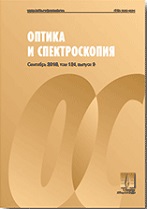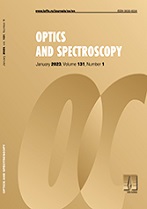|
This article is cited in 1 scientific paper (total in 1 paper)
Spectroscopy and physics of atoms and molecules
Features of the excitation of lines of the principal series of zinc-subgroup atoms by electron impact. I. Cadmium
H. G. Bohachov, E. Yu. Remeta
Institute of Electron Physics, National Academy of Sciences of Ukraine, Uzhgorod, Ukraine
Abstract:
Using the technique of crossed beams of slow electrons and cadmium atoms, the excitation functions of three spectral lines of its principal series (166.9, 152.7, 146.9 nm) outgoing from the $5snp^{1}P^\circ_{1}$ levels were measured ($n$ = 6, 7, 8, respectively). In the range of electron energies 12–18 eV, a manifestation of the post-collision interaction of slow scattered electrons and fast electrons ejected during the decay of autoionizing states was found in these functions. This process, at incident electron energies of $\sim$11.8, $\sim$12.4, and $\sim$16.6 eV, leads to additional population of the initial levels of spectral transitions and, correspondingly, to maxima on the excitation functions due to the capture of a scattered electron to these excited levels. The terms of autoionizing states of the atom responsible for the observed maxima on the excitation functions of spectral lines are established. In the classical approximation, by two methods – direct calculation and least squares approximation – estimate the effective widths of the electronic decay of autoionizing states, the combined action of which leads to an energy shift of the maxima. Approximate calculation formulas are used, which are valid for various relations between the post-collision shift of the maxima on the excitation functions and the binding energy of atomic levels.
Keywords:
collisions of electrons with atoms, excitation, vacuum ultraviolet, autoionizing state, post-collision interaction.
Received: 11.09.2019
Revised: 29.10.2019
Accepted: 01.11.2019
Citation:
H. G. Bohachov, E. Yu. Remeta, “Features of the excitation of lines of the principal series of zinc-subgroup atoms by electron impact. I. Cadmium”, Optics and Spectroscopy, 128:2 (2020), 176–185; Optics and Spectroscopy, 128:2 (2020), 172–181
Linking options:
https://www.mathnet.ru/eng/os463 https://www.mathnet.ru/eng/os/v128/i2/p176
|


| Statistics & downloads: |
| Abstract page: | 36 | | Full-text PDF : | 17 |
|





 Contact us:
Contact us: Terms of Use
Terms of Use
 Registration to the website
Registration to the website Logotypes
Logotypes








 Citation in format
Citation in format 
